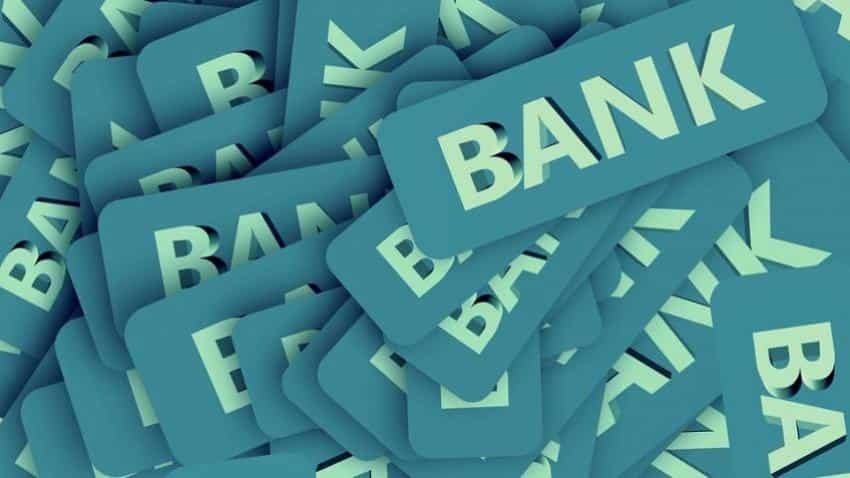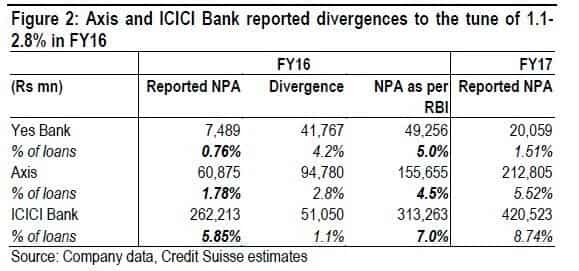Divergence in NPA classification: More stress ahead for banks
Three large private sector banks have disclosed divergence in non-performing assets (NPAs), and this has made India Ratings believe that a significant portion of unrecognised bad loans in the system will start trickling in the next 12-18 months.

Highlights:
- Rs 2.6 lakh crore of corporate and SMEs loans – which would be 3.2% of total bank credit will be recognised as stressed loans.
- ICICI Bank, Yes Bank and Axis Bank have disclosed divergence in non-performing assets (NPAs).
- Crisil Research expects absolute gross NPAs and weak assets to touch about Rs 7.8 lakh crore and Rs 8.7 lakh crore.
The bad loan problem of Indian banks arising out of its stressed assets and non-performing assets (NPAs) may be far from over.
India Ratings, in its report said, “We estimate that potentially Rs 2.6 lakh crore of corporate and SMEs loans – which would be 3.2% of total bank credit will be recognised as stressed loans by financial year 2019.”
Three large private sector banks have disclosed divergence in non-performing assets (NPAs), and this has made India Ratings believe that a significant portion of unrecognised bad loans in the system will start trickling in the next 12-18 months.

Yes Bank, in its financial report, showed gross NPAs worth Rs 748.9 crore in FY16. However, as per the RBI's assessment, the bank's bad loans were worth Rs 4,925 crore – which would mean a divergence of Rs 4,176.7 crore.
Yes Bank clarified that the disclosure made in divergence in asset classification and provisions in non-performing assets (NPAs) in its Annual Audited Financial Statement is in conformity with the Reserve Bank of India (RBI) guidelines.
Similarly, Axis Bank which reported Rs 6,087.5 crore of gross NPA in FY16, recorded a divergence of Rs 9,478 crore.
ICICI Bank reported Rs 26,221 crore in FY16 – a divergence of Rs 5,105 crore during the period.
RBI, in April 2017 said, "There have been instances of material divergences in banks’ asset classification and provisioning from the RBI norms, thereby leading to the published financial statements not depicting a true and fair view of the financial position of the bank.”
Sumeet Kariwala Subramanian Iyer, Anil Agarwal and Rahul Gupta of Morgan Stanley, in a report titled 'Annual Report Takeaway -- High GNPL Divergence with RBI' dated May 12, 2017 said, “We expect investors to be closely tracking this data at all banks, and would also be concerned about potential divergence in FY17 results as well."
India Ratings estimates that banks have been sitting on unrecognised stressed loans worth Rs 7.7 lakh crore including both corporates and SME debt – which holds 22% of total bank credit.
Also Read: Solving NPA problem is a long process, RBI first needs to discipline banks
Madan Sabnavis and Manisha Sachdeva, economists at Care Ratings said, “It seems that these private sector banks may have reached a stage where they have completed the process of recognising the Non-Performing assets.”
Care Ratings said, "The question posed is whether this is a plateau reached by these banks or whether the number could increase in the coming quarters. Some of these banks have reported that they have managed to lower the volume of NPAs at a faster pace than fresh slippages, which is a positive sign for the system as it does indicate that the worst may be behind us."
"While the iron and steel sector has seen lot of stress recognition in the AQR exercise conducted by the RBI in the last fiscal, provisioning continues to remain inadequate considering higher loss given default estimates, " added India Ratings.
India Ratings expects impaired assets to peak at 12.5%-13% by FY18/FY19 while credit costs will show an extended recovery period as a large proportion of the recently acquired higher–bucket non-performing loans keep aging.
Crisil Research expects absolute gross NPAs and weak assets to touch about Rs 7.8 lakh crore and Rs 8.7 lakh crore, respectively by March 31, 2017.
Further, with credit growth expected to be around 5%-8% for fiscal 2017, gross NPAs and weak asset ratios could hover 9.5% and 10.5%, respectively.
10:28 AM IST






 Disclose names of defaulters, suggests parliamentary panel
Disclose names of defaulters, suggests parliamentary panel Punjab National Bank, Union Bank bad loan growth slows but provisions weigh
Punjab National Bank, Union Bank bad loan growth slows but provisions weigh Jaitley likely to hold meeting with bankers on Nov 11-12
Jaitley likely to hold meeting with bankers on Nov 11-12 Q2FY18 preview: RBI's NPA resolution under IBC to weigh on banks' earnings
Q2FY18 preview: RBI's NPA resolution under IBC to weigh on banks' earnings  Fewer and stronger PSU banks but what about their stressed assets?
Fewer and stronger PSU banks but what about their stressed assets?